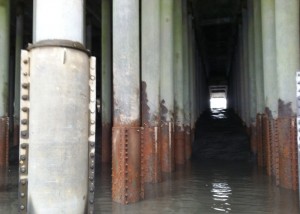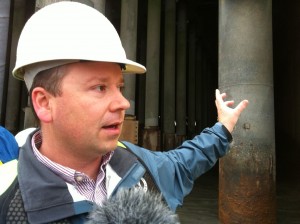The Anchorage Port project is taking a new direction toward modernization and rehabilitation instead of expansion.
Underneath the wharf at the Port of Anchorage stand 1,400 hollow steel posts. The lower sections of the damp metal are covered in thick reddish-brown corrosion caused by bacteria, silt, and salty water. Thick steel sleeves have been bolted around some of them to cover cracks and holes. The sleeves have started to corrode as well. Port Engineer Todd Cowles calls them Band-Aids.

“You can spend 15 years fixing 100 piles a year only to have the ones you started with starting to fail. These are not 75-year solutions. These are 10- to 15-year solutions. So you invest as much up front cost to get much less return on their investment,” he says.
So now the Municipality of Anchorage and CH2M Hill are designing three possible long-term solutions to the problem. The basic idea is to use steel piles filled with reinforced concrete. If the steel corrodes away in 20 years, the concrete keeps standing.
Port managers want to completely re-do two of the four aging terminals, replace aging cranes and other infrastructure with modern equipment, and make the port more earthquake proof. They will not add any more berths.
Cowles says construction will change the flow of work for many of the companies that off-load goods at the Port.
“We have to move these customers south to be able to make that happen because we’re planning a wholesale demolition and reconstruction.”
The project is a far cry from the failed expansion started in 2006 that resulted in $312 million in expenditures, piles of unused materials, and multiple lawsuits. Cowles says this time they took a different approach to the project.
“I think what we did better this time is really involve our primary stakeholders in kind of kicking the tires on the concept.”
They held a week-long meeting with engineers, pilots, and port users in late August. The designs will be developed enough to estimate their price tags, layouts, and potential risks.

They’ll be presented to the Municipality in early November.
Four million tons of goods pass through the Port each year as well as a majority of all the cement and jet fuel used in the state. Cowles says the port projects have not interrupted any port activities to date.
Anne Hillman is the healthy communities editor at Alaska Public Media and a host of Hometown, Alaska. Reach her at ahillman@alaskapublic.org. Read more about Anne here.





